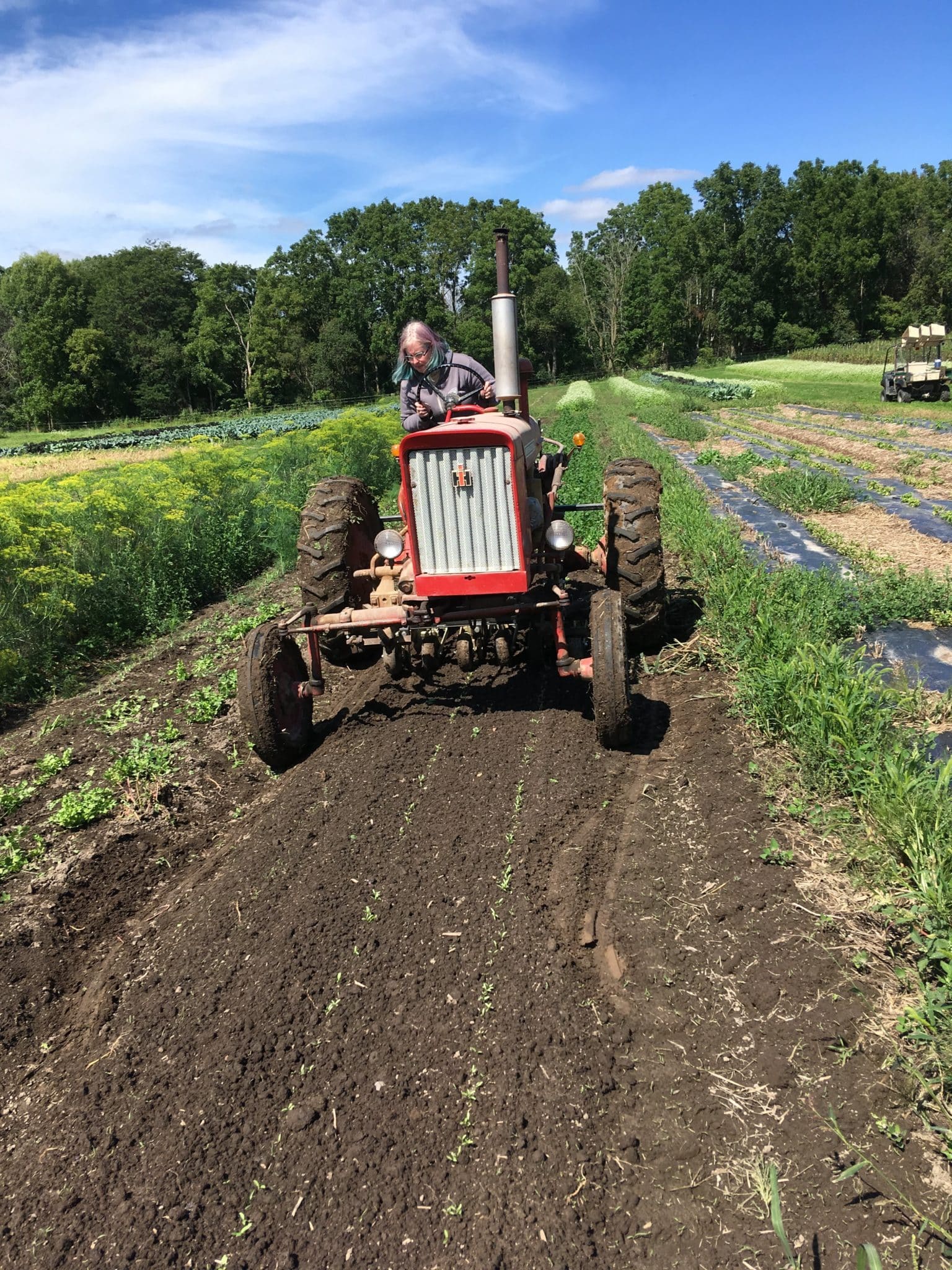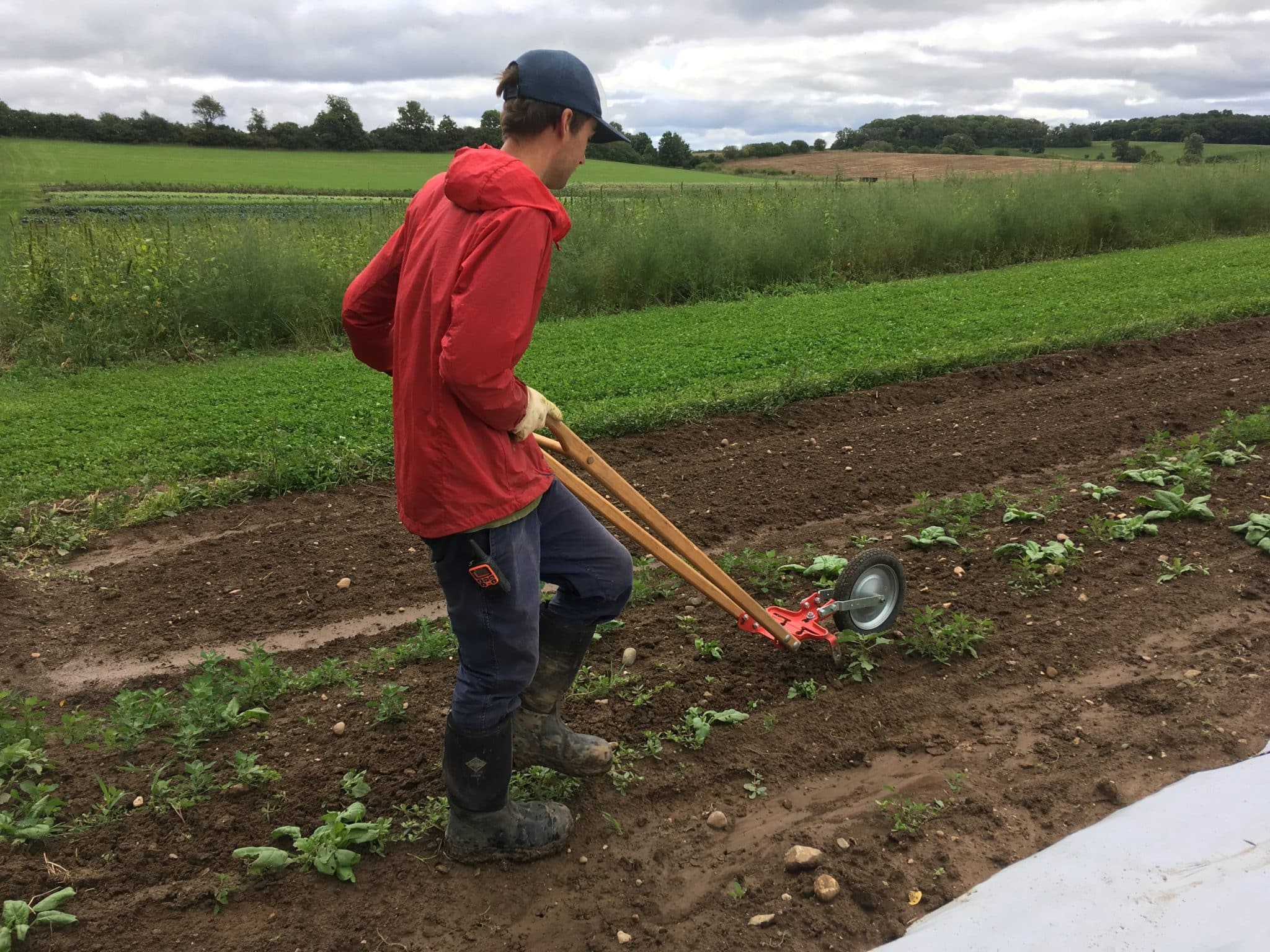
By Laurel Blomquist | Earlier this year, I wrote about Gwenyn Hill Farm’s organic management practices, relating to Gwenyn Hill Farm’s organic fertilization and pest management strategies. This time, I’d like to talk about how we deal with weeds.
What is a Weed?
What exactly is a weed? A weed is a plant that is growing in a place where you don’t want it. In other words, if a tomato plant is growing in your squash patch, that tomato plant is a weed. You may find “volunteers” like this pop up from year to year in your garden. Other weeds are more obvious: pigweed (amaranth), lamb’s quarter, purslane, velvet leaf, dandelion, bindweed, Canada thistle, plantain, crabgrass, quack grass, chickweed, shepherd’s purse, and more can thrive with no effort on your part.
Why do we want to remove weeds? Weeds compete with the plants that we grow for nutrients, sunlight, water, and space. If we let the weeds take over, we will often lose a crop, or at least see much lower yields than we were expecting. Weeds have a competitive advantage over cultivated plants, in that they are adapted to their natural habitat.
In some conventional systems, farmers use special seeds that have been genetically modified to withstand chemical herbicides. They plant the seeds, wait for them to germinate, and spray chemicals. This kills all the vegetation except those plants which have been modified.
Organic Weed Prevention
In organic systems, we do not use chemical herbicides. Instead, we must physically prevent or remove weeds from the areas that we plant. There are several things we can do to prevent and remove weeds.
One is by lessening the weed seed “bank” in the soil from year to year. When we see weeds growing, we make sure to pull them or mow them before they start to make seeds. That will reduce the number of seeds that are created year after year in the same space. In fields where we are not planting a cash crop, we will plant cover crops which will compete with weeds, smothering them out before they can take hold of the field.
Another technique is called ‘stale seed bedding’. This means that we work the soil by tilling one to two weeks before we actually want to plant anything. We wait for weeds to germinate, and then we cultivate to kill those baby weeds just before we plant.
Flame Weeding
We can also use a flame weeder. This tool is essentially a backpack filled with propane attached to a wand that shoots a propane flame. The flames kill the weeds by overheating their cell walls, causing them to burst. We like to use this tool with carrots, since baby carrots are so small and difficult to cultivate using machinery and germinate much more slowly than most common weeds. This gives us a window of opportunity between the sprouting of weeds and carrots during which we can safely flame without killing the carrots.
Another strategy is planting into straw mulch, plastic mulch, or landscape fabric. This is particularly useful for plants that will be in the ground over a long season, such as winter squash, tomatoes, or strawberries. The mulch acts as a barrier to weeds, preventing them from getting sunlight. Plastic mulch also prevents weeds from getting water. We place drip tape under the plastic mulch so that the plants that we want to grow will have enough water. Straw mulch has the benefit of adding organic matter to the soil at the end of the season.
Another prevention strategy is to use transplants. We plant seeds into trays in the greenhouse as early as February. This allows the plants to be healthy and strong when they get planted outside. In some cases, planting this way is necessary for our short growing season here in Wisconsin. For example, tomatoes would rarely produce fruits before the fall frost if they were not started in the greenhouse. Transplanting also gives plants an advantage over weeds, since they are quite a bit larger and have the potential to shade out the weed sprouts.
Organic Weed Removal & Cultivation

There are lots of seeds that get planted on bare soil, such as carrots, radishes, cilantro, and beets, so we need to have a strategy for dealing with these weeds before they overtake those crops. We have several tools that we can use for cultivating a few days after the seeds are planted. These are essentially knives or fingers that rough up the surface of the soil, killing off weeds while they are still quite small. We can run these cultivators through the plants once a week for a few weeks, until the plants are too large for the knives.
Some cultivators work best with slightly larger plants, and can be used on transplants that are planted into soil, such as broccoli and cauliflower. Other cultivators are designed to kill weeds by covering the plant with soil. This may sound strange, but vegetables such as potatoes and leeks need to be hilled so that they remain white. In that case, the cultivator is efficiently doing two jobs at the same time.
Weeding By Hand
Once plants get to be too large to cultivate by machine, we can continue weeding by hand. We have several tools that we can use to make hand weeding faster and more efficient. One such tool is the wheel hoe. The hoe is attached to a frame that rides on a wheel, making it easy to push the hoe back and forth down a long row of plants. Other hoes are designed to make it easy to clean the area between the plants; within the row. And when weeds and plants are very close together, nothing works better than a hand hoe.

Hand weeding is tedious and time consuming, but if we have taken the time to prevent weeds through our other techniques, there should be less to do, if not this season, then the next. The beauty of a weed-free field is a sight to behold!
Gwenyn Hill Farm is hosting the Third Annual Midwest Mechanical Weed Control Field Day on Wednesday, September 18th. More information and registration can be found here.

